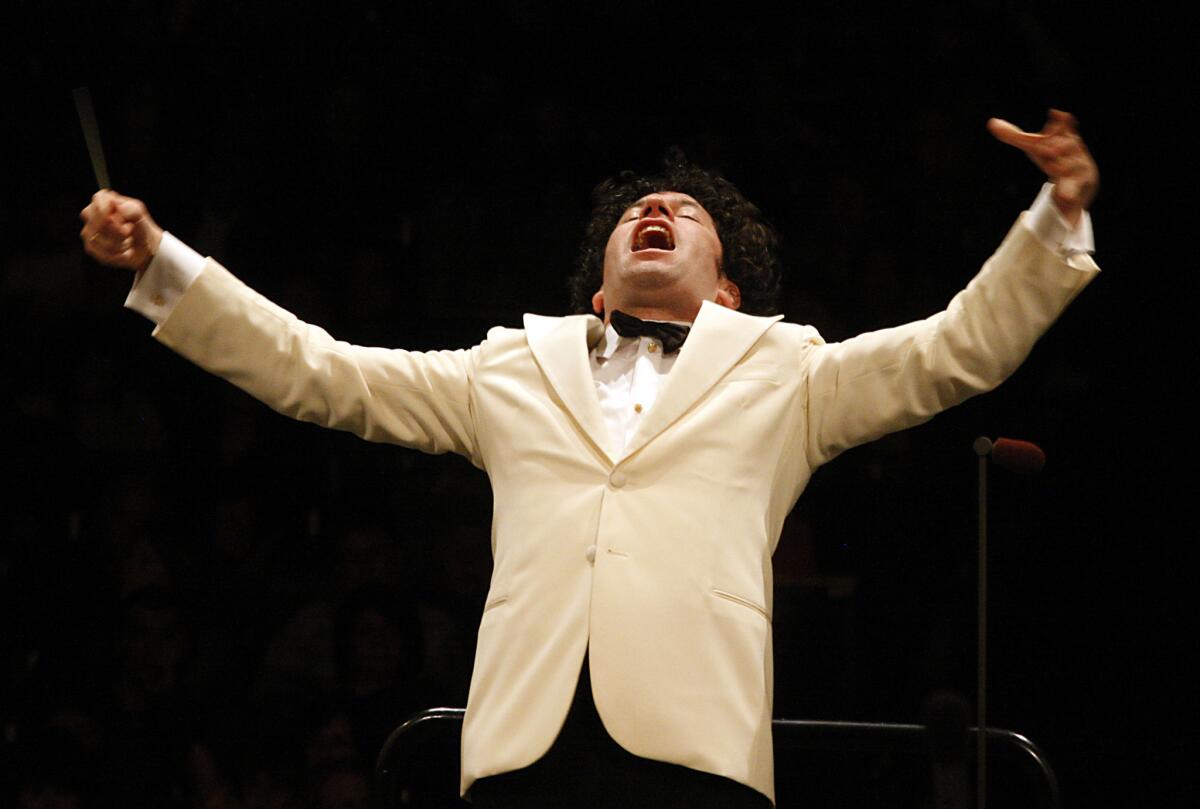From the Archives: Bowled over by L.A.’s new maestro

- Share via
And so, Saturday, it came to pass. After all the extraordinary buildup — the billboards and the bilingual media frenzy — 18,000 people from every corner of the city came to the Hollywood Bowl to bear witness.
He goes by many names: Gustavo the Great. Gustavissimo. The Dude. Some have taken to referring to the new music director of the Los Angeles Philharmonic by his initials, thus: G*D.
It’s all too much, we critics judiciously caution. But in his first return to the Hollywood Bowl since making his U.S. debut there in 2005, the Dude pulled it off. Joy reigned. On Saturday, Gustavo Dudamel concluded “¡Bienvenido Gustavo!” — the 28-year-old Venezuelan conductor’s first concert as the L.A. Philharmonic’s music director — with a Beethoven Ninth to be remembered.
FULL COVERAGE: Inside the L.A. Philharmonic
This was not so much a Beethoven Ninth for the ages (he has a lot of competition), as it was a performance of Beethoven’s last and largest symphony, an iconic work of classical music with a cosmic scope and a call for universal brotherhood, for multicultural Los Angeles at this moment.
Perhaps, most important, this was Beethoven for all ages. Dudamel made his first appearance on stage with the nearly 100 children of YOLA Expo Centre Youth Orchestra, who have had instruments in their hands only a little more than a year. As they sawed through a version by Steven Venz of Beethoven’s “Ode to Joy” from the Ninth’s last movement, they showed determination and pride. They had something to prove and they proved it, and that was an indescribable thrill.
Leonard Bernstein once said that we can never express too much joy when it comes to Beethoven, and Dudamel took him at his word. He needed some time warming up. Dudamel is not all Dionysian all the time, but the Greek god of pleasure was always looking over his shoulder.
This Ninth started out with proper seriousness. The craggy opening movement, a kind of calling up of creation, needed more depth of sound. But to achieve that it would have also needed more depth from a sound system still warming up.
The dance-like second movement had great snap and was followed by a rapturous slow movement.
But it wasn’t until the final movement, with its setting of Schiller’s “Ode to Joy,” that Dudamel really began to demonstrate what all the fuss is about. In the opening, crazy made a sudden turn to grace. A chorus of nearly 200 (the Los Angeles Master Chorale supplemented with members from several local choruses) and four terrific vocal soloists (Measha Brueggergosman, Michelle DeYoung, Toby Spence and Matthew Rose) reached possible record levels of exhilaration.
Here, Dudamel tested limits. He took the final measures faster than reasonable but just short of impossible. A full moon rose over the Bowl’s hedges, as if elevated by the energy on stage. The camera panned over a multicultural chorus for the Bowl’s large video screens. Schiller’s quaint text was translated in alternating English and Spanish.
When it was over, Dudamel spoke briefly of the meaning of Beethoven, of the children and our future.
We are a continent together, he said, no North, no South, no Central America. He then repeated the last five minutes of the symphony with fireworks. It felt, at that moment, like the greatest show on earth.
More to Read
The biggest entertainment stories
Get our big stories about Hollywood, film, television, music, arts, culture and more right in your inbox as soon as they publish.
You may occasionally receive promotional content from the Los Angeles Times.











